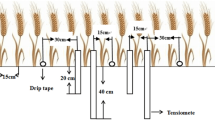Summary
Root density profile of three varieties grown along a toposequence under three soil moisture regimes was estimated from soil moisture depletion patterns in the soil profile. Each of the three varieties, IB 6, IR 1529-680-3 and IET 1444, had a different rooting pattern. The three soil moisture regimes corresponded to water table depths of 100 (M1), 30 (M2) and 15 cm (M3) below the soil surface. Soil moisture potential was negatively correlated with root density, and the differences in rate of moisture depletion at various depths were due largely to differences in root activity. However, varietal differences in root activity were observable only within a narrow range of soil moisture potential, generally above −0.60 bar.
Similar content being viewed by others
References
Burton G W 1964 Role of tracers in root development investigations.In Atomic Energy and Agriculture, C L Comar (Ed.) Publ. no. 49. Am. Assoc. for Advancement of Sci., Wash. D.C., 71–80 (1957).
Gardner W R 1964 Relation of root distribution to water uptake and availability. Agron J. 56, 35–41.
Jones C A, Tan Nguyen and Zimmerman F J P 1979 Root system development in rice on three brazilian latosols.In R Lal and D J Greenland (Eds.). Soil Physical Properties and Crop Production. J. Wiley and Sons, Chichester, U.K. 385–396.
Hsiao T C, O'Toole J C and Tomar V S 1980 Water stress as a constraint to crop production in the Tropica.In Proc. of Priorities For Alleviating Soil Related Constraints T-Food Production In the Tropics. IRRI, Los-Banos, Philippines.
Hurd E R 1974 Genotype and drought tolerance in wheat. Agr. Meteor. 14, 317–353.
Lee D K and Prominitz L C 1978 Sampling and Estimation of hybrid popular root systems. Iowa State J. of Research 53(1), 1–12.
Mambani B 1980 Plant-water Relations as a Criterion for Screening for Drought Resistance in Rice. Unpublished doctoral dissertation University of Zaire, IFA, Yangambi.
Mambani B and Lal R 1982 Varietal response to drought stress in upland rice II. Screening rice varieties using variable moisture regimes along a toposequence. Plant and soil (Submitted).
Moorman F R, Lal R and Juo A S R 1975 The soils of IITA. Intern. Inst. Trop. Agr. Techn. Bull. No. 3.
O'Toole J C and Chang T T 1978 Drought and rice improvement in perceptive. IRRI, Research Paper Series No. 4, Los Banos, Philippines.
Renyiers, F M and Bnh T 1978 Screening with P32 for rooting depth among varieties of rainfed rice.In I Buddenhagen and G Persley (Eds.), Rice in Africa. Academic Press, London, U.K.
Steponkus P L, Cutler J M and O'Toole J C 1979 Adaptation to water deficit in rice.In N C Turner and P J Kramer (Eds), Adaptation of Plants to Water and High Temperature Stress. Wiley Interscience, New York, U.S.A.
Yoshisuke F 1974 The morphology and physiology of rice roots. Food and Fertilizer Techn. Center Techn. Bull. No. 2.
Author information
Authors and Affiliations
Rights and permissions
About this article
Cite this article
Mambani, B., Lal, R. Response of upland rice varieties to drought stress. Plant Soil 73, 95–104 (1983). https://doi.org/10.1007/BF02197759
Received:
Revised:
Issue Date:
DOI: https://doi.org/10.1007/BF02197759




